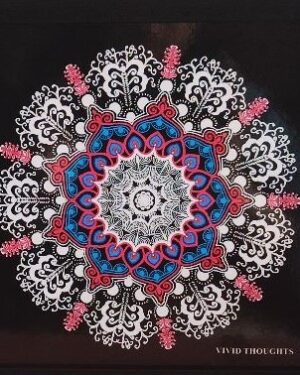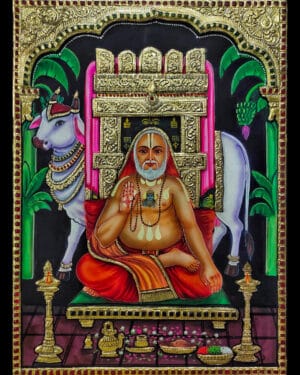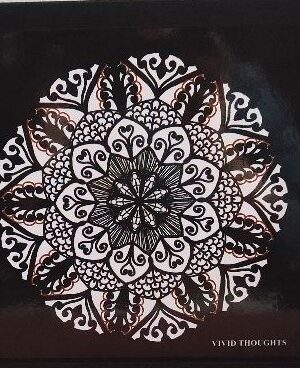Description
Warli Painting from Maharashtra is among the finest examples of the folk style of paintings that have managed to survive for thousands of years. Warli painting is a form of tribal art mostly created by the tribal people from the North Sahyadri Range in Maharashtra, India.
The Warli tribe is one of the largest in India, located outside of Mumbai. Despite being close to one of the largest cities in India, the Warli reject much of contemporary culture. The tribal style of art is thought to date back as early as 10th century A.D.
The Warli culture is centered on the concept of Mother Nature and elements of nature are often focal points depicted in Warli painting. Farming is their main way of life and a large source of food for the tribe. They greatly respect nature and wildlife for the resources that they provide for life. Warli artists use their clay huts as the backdrop for their paintings, similar to how ancient people used cave walls as their canvases
These rudimentary wall paintings use a set of basic geometric shapes: a circle, a triangle, and a square. These shapes are symbolic of different elements of nature. The circle and the triangle come from their observation of nature. The circle represents the sun and the moon, while the triangle is derived from mountains and pointed trees. In contrast, the square appears to be a human invention, indicating a sacred enclosure or a piece of land. The central motif in each ritual painting is the square, known as the “chauk” or “chaukat”, mostly of two types known as Devchauk and Lagnachauk. Inside a Devchauk is usually a depiction of Palaghata, the mother goddess, symbolizing fertility.
Male gods are unusual among the Warli and are frequently related to spirits which have taken human shape. The central motif in the ritual painting is surrounded by scenes portraying hunting, fishing, and farming, and trees and animals. Festivals and dances are common scenes depicted in the ritual paintings. People and animals are represented by two inverse triangles joined at their tips: the upper triangle depicts the torso and the lower triangle the pelvis. Their precarious equilibrium symbolizes the balance of the universe. The representation also has the practical and amusing advantage of animating the bodies. Another main theme of Warli art is the denotation of a triangle that is larger at the top, representing a man; and a triangle which is wider at the bottom, representing a woman. Apart from ritualistic paintings, other Warli paintings covered day-to-day activities of the village people.
One of the central aspects depicted in many Warli paintings is the tarpa dance. The tarpa, a trumpet-like instrument, is played in turns by different village men. Men and women entwine their hands and move in a circle around the tarpa player. The dancers then follow him, turning and moving as he turns, never turning their backs to the tarpa. The musician plays two different notes, which direct the head dancer to either move clockwise or counterclockwise. The tarpa player assumes a role similar to that of a snake charmer, and the dancers become the figurative snake. The dancers take a long turn in the audience and try to encircle them for entertainment. The circle formation of the dancers is also said to resemble the circle of life.

![Family Feast - Original Warli Wall Painting [Digital Image]](https://indianfolkart.org/wp-content/uploads/2021/02/WhatsApp-Image-2021-02-09-at-1.44.51-PM-1.jpeg)

![Cooking Time, Original Warli Wall Painting [Digital Image]](https://indianfolkart.org/wp-content/uploads/2021/02/WhatsApp-Image-2021-02-09-at-1.44.51-PM-300x375.jpeg)
![Mother Gathering Coconut, Original Warli Wall Painting [Digital Image]](https://indianfolkart.org/wp-content/uploads/2021/02/WhatsApp-Image-2021-02-09-at-1.44.52-PM-1-300x375.jpeg)
![Towing Grain On Cart, Original Warli Wall Painting [Digital Image]](https://indianfolkart.org/wp-content/uploads/2021/02/WhatsApp-Image-2021-02-09-at-1.44.52-PM-3-300x375.jpeg)
![Nature, bird and animal, Original Warli Wall Painting [Digital Image]](https://indianfolkart.org/wp-content/uploads/2021/02/WhatsApp-Image-2021-02-09-at-1.44.52-PM-300x375.jpeg)
![Carrying Tiger, Original Warli Wall Painting [Digital Image]](https://indianfolkart.org/wp-content/uploads/2021/02/WhatsApp-Image-2021-02-09-at-1.44.52-PM-2-300x375.jpeg)
![Harvest Time, Original Warli Wall Painting [Digital Image]](https://indianfolkart.org/wp-content/uploads/2021/02/WhatsApp-Image-2021-02-09-at-1.44.51-PM-2-300x375.jpeg)


![Annapoorani, Tanjore Painting [Digital Download Only]](https://indianfolkart.org/wp-content/uploads/2021/02/Annapoorani-3-300x375.jpg)

Reviews
There are no reviews yet.